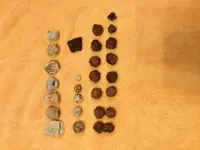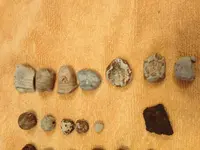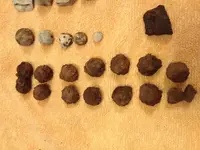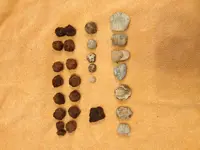MarkP, since you asked for me by name, here is my analysis of tour 14 unusually-small iron balls.
By the way, if they are from the civil war they not made of steel, but instead are cast-iron. There is no record of manufacturing any steel artillery balls in the civil war era... except for a few British Navy 10"-caliber Solid-Shot anti-ironclad balls, which never got used over here in America.
The size of your 14 iron balls is the key to correctly identifying them. Super-precise measuring is needed for certainty of ID... so please clean them and report their exact size. The simplest way to clean the rust-crust off a few of them for super-accurate measurement is to put them on a concrete driveway and bash the crust off with a hammer. (You can coat them with Polyurethane afterward.)
Meanwhile, I'll go with your statement that they "average" a half-inch in diameter. The term "average" means some of the 14 are larger and some are smaller.
All known civil war Canister balls are .66" or more in diameter.
They might be a particular variety of Case-Shot balls. Let's do the process-of-elimination. Schenkl and Parrott never used iron Case-Shot balls. But early-model 3" Hotchkiss and 3" Dyer projectiles, and CS "Sideloaders" did use iron Case-Shot balls. However, they were .56" balls, or larger. The only Case-Shot projectile I know of that used iron balls smaller than .56" is the extraordinarily rare James Case-Shot... which has only been found in West Virginia, the state where you live.
So, we MIGHT have a winner with the James Case-Shot. However, as mentioned above... usually, the lack of any James or other kinds of shell fragments in the area where the balls were found indicates Canister as the answer. But there were no Canister balls smaller than .66-inch. The lack of any kind of shell fragments in the area makes me have to also consider the possibility that your "average half-inch diameter" balls are ball-bearings.
Please tell us the diameter of the cleaned-up balls when you get that information.






